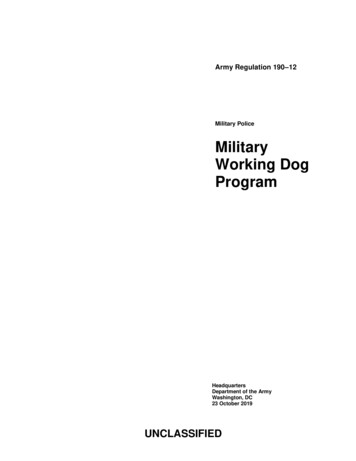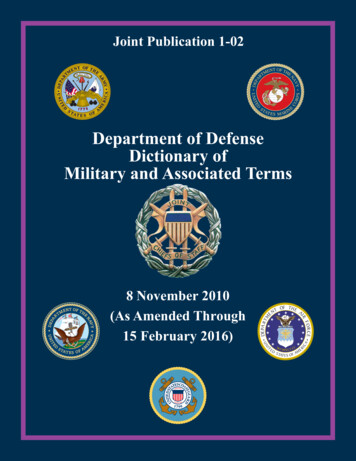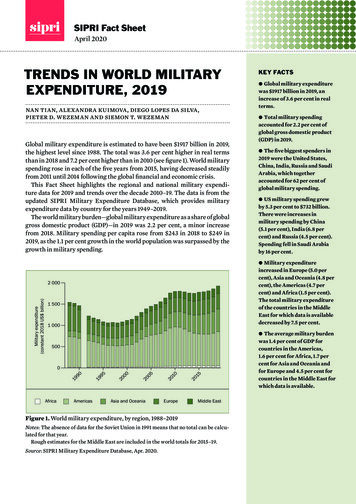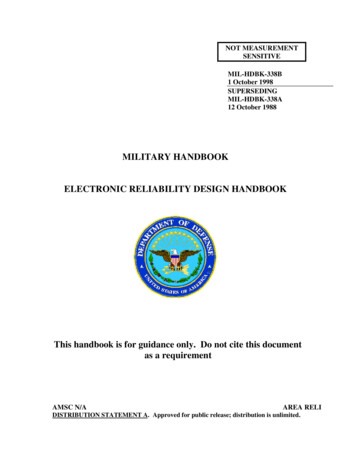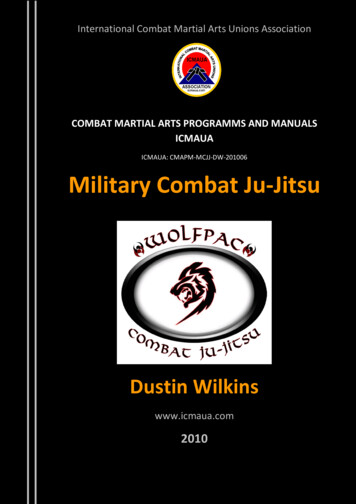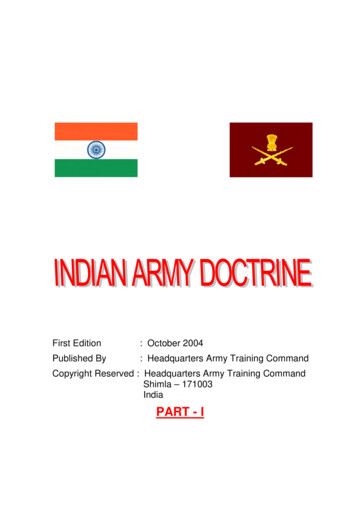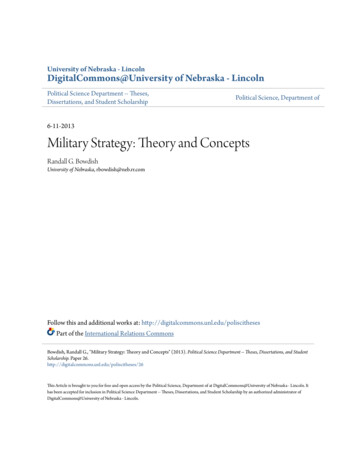
Transcription
University of Nebraska - LincolnDigitalCommons@University of Nebraska - LincolnPolitical Science Department -- Theses,Dissertations, and Student ScholarshipPolitical Science, Department of6-11-2013Military Strategy: Theory and ConceptsRandall G. BowdishUniversity of Nebraska, rbowdish@neb.rr.comFollow this and additional works at: http://digitalcommons.unl.edu/poliscithesesPart of the International Relations CommonsBowdish, Randall G., "Military Strategy: Theory and Concepts" (2013). Political Science Department -- Theses, Dissertations, and StudentScholarship. Paper his Article is brought to you for free and open access by the Political Science, Department of at DigitalCommons@University of Nebraska - Lincoln. Ithas been accepted for inclusion in Political Science Department -- Theses, Dissertations, and Student Scholarship by an authorized administrator ofDigitalCommons@University of Nebraska - Lincoln.
MILITARY STRATEGY: THEORY AND CONCEPTSByRandall G. BowdishA DISSERTATIONPresented to the Faculty ofThe Graduate College at the University of NebraskaIn Partial Fulfillment of RequirementsFor the Degree of Doctor of PhilosophyMajor: Political ScienceUnder the Supervision of Professor Ross A. MillerLincoln, NebraskaJune 2013
MILITARY STRATEGY: THEORY AND CONCEPTSRandall G. Bowdish, Ph.D.Univerity of Nebraska, 2013Adviser: Ross A. MillerMilitary strategy was long described as atheoretical—an art that could only befully comprehended by military genius. This contention is no longer held, as militarystaffs, comprised of experts and specialists, are able to formulate strategy aided by minitheories of strategy and a process that takes advantage of collective wisdom rather thansingular genius. But the mini-theories of strategy remain underdeveloped and anoverarching theory of military strategy does not yet exist. In this dissertation I build agrand theory of military strategy, consisting of a simple two-pole, physical andpsychologically oriented framework, mini-theories of military strategy, and additionally,concepts of employment that describe conceptual actions that can be employed bymilitary means to achieve military objectives. Mini-theories of military strategy,consisting of the five basic military strategies of extermination, exhaustion, annihilation,intimidation and subversion, are woven together into a coherent military strategytheoretical framework. Additionally, I expose the principles of war as a myth, insteadproffering concepts of employment as the actionable elements of strategy, which are usedin the conceptual direction of military means to achieve military objectives in support andamplification of the five basic military strategies. The strategies offered are the result of acomprehensive meta-data analysis, hermeneutical analysis, and comparative metaanalysis of the works of past strategy theorists, rather than the case study methodologyemployed in most military strategy scholarship. This dissertation provides a baselinetheory from which further military strategy hypotheses can be generated and tested inorder to advance our understanding of military strategy.
Copyright 2013Randall G. BowdishALL RIGHTS RESERVED
ivACKNOWLEDGMENTSI would like to thank Dr. Ross A. Miller for his patience and sage counsel in thepreparation of this dissertation. He was the perfect advisor for this old sea-dog (retiredNavy Captain). Encouraging and demanding on the academic side, yet reverent andrespectful towards my military experience, he treated me as a peer and not just anotherbothersome student. I would also like to thank my committee members, Dr. Nam KyuKim, Dr. Kevin Smith, and Dr. Peter Bleed, for their insightful comments andrecommendations. Most of all, I thank my wife, *Kate, daughter Brittany, and son,Brandon, for their loving support.
vTable of ContentsCHAPTER 1: INTRODUCTION . 1Purpose. 4Limitations and Delimitations. 6CHAPTER 2: RESEARCH DESIGN AND METHODOLOGY. 7Theory Building and the Philosophy of Science. 8Concepts. 13Meta-study . 16Grounded Theory . 20Research Design. 23Methodology . 27CHAPTER 3: THE MASTER STRATEGISTS . 33Sun Tzu and The Art of War. 33Ancient Chinese Military Classics and the Thirty-Six Stratagems. 40CHAPTER 4: THE EARLY ANNIHILATORS . 48Carl von Clausewitz, On War . 48Baron De Jomini . 62CHAPTER 5: THE EXHAUSTERS . 70Frederick the Great . 70Hans Delbrück . 76CHAPTER 6: THE SUBVERTERS. 80Marx, Engels, and Lenin. 81Mao Tse Tung and Protracted Popular War . 88Yuri Bezmenov and the KGB . 99Conclusion . 102CHAPTER 7: THE MODERN ANNIHILATORS . 104B.H. Liddell Hart . 105John Boyd . 111CHAPTER 8: THE UNRESTRICTED . 116André Beaufre. 116PLA Colonel’s Liang and Xiangsui, Unrestricted Warfare and PLA General’s Pengand Yao, The Science of Military Strategy. 126CHAPTER 9: THE PRINCIPLES AND CONCEPTS OF WAR . 133Principles and Concepts of War—a Napoleonic Heritage. 134Strategy and the Principles. 140The Principles in Small Wars . 141The Spectrum of Conflict Expands. 151
viAnnihilation-based Doctrine and Operational Concepts . 160War and Operations Other Than War . 165Joint Doctrine Becomes Authoritative. 167Infatuation with Operational Concepts . 171Counterinsurgency Doctrine . 174An Expanded List of Principles of Joint Operations . 177CHAPTER 10: CONCEPTS OF EMPLOYMENT. 184Principles and Operational Concepts . 184Selected Concepts of Employment . 187Concepts as Strategies. 188The Physical Concepts of Employment. 191Psychological Concepts of Employment . 193Organizational Concepts of Employment. 196Conclusion . 199CHAPTER 11: THE FIVE BASIC MILITARY STRATEGIES . 201The Strategy of Extermination. 201Strategy of Exhaustion. 205The Strategy of Annihilation . 212The Strategy of Intimidation. 223The Strategy of Subversion. 229Conclusion . 239CHAPTER 12: A GRAND THEORY OF MILITARY STRATEGY . 240The Basic Military Strategy Continuum . 241The Basic Military Strategies and the Concepts of Employment . 245Horizontal Combinations of the Five Basic Military Strategies. 249Vertical Linkages and Levels of the Basic Military Strategy Continuum . 250Types of Warfare . 252Conclusion . 255REFERENCES . 257APPENDIX: WHAT IS MILITARY STRATEGY?. 268Etymology of Strategy . 269The Traveling Problem of Strategy. 272Key Terms. 274GLOSSARY OF MAJOR CONCEPTS . 287
viiLIST OF TABLESTable 2.1Table 2.2Table 3.1Table 8.1Table 8.2Table 8.3Table 9.1Table 10.2Table 11.1Table 12.2Sartori’s guidelines for concept formation.Criteria of Conceptual Goodness.The Thirty-Six Stratagems.Beaufre’s patterns of strategy.Beaufre’s interpretation of the rules of strategy.Means and Methods of Warfare.U.S. Principles of War 1921-1949.International Principles of War circa 1981.Concepts of employment organized by physical, organizational,and psychological actions.Types of warfare are stylized from single strategies andcombinations of strategies.151746117119127138160188251
viiiLIST OF FIGURESFigure 9.1Figure 9.2Figure 10.1Figure 12.1Figure 12.2Armed conflicts by type and year.The Range of Army Operations.The two types of annihilation strategies.The Basic Military Strategy Continuum.The relationship between concepts of employment and strategy.153168212240245
PART I: PRELIMINARIES
1CHAPTER 1: INTRODUCTION“The nation that will insist on drawing a broad line of demarcation between thefighting man and the thinking man is liable to find its fighting done by fools andits thinking done by cowards."Sir William Francis ButlerThere is some truth to the old military adage that “God always favors the bigbattalions”.1 Military history provides many examples of the bigger and richer sidewinning in war. In a study of 40 wars from 1815 to 1945, Rosen (1999) found that twopowerful predictors of victory were the wealth of a nation (79% of the cases) andpopulation size (which explained 70% of the cases). But these are not the cases thatcaptivate and intrigue us. David beating Goliath, Alexander the Great and his 30,000Macedonians defeating Darius and his Persian force of over 100,000 at Issus, Hannibaland his 50,000 troops annihilating Terentius Varro and 87,000 Romans at Cannae are justa few examples of battles within wars that remain conspicuous for the simple fact that thesmaller force defeated the larger. For warfare theory to have any traction withpractitioners of war, it must account for cases such as these. The question that beckons ishow the little guy beat the big guy.The answer lies in the confluence between capabilities, resolve and strategy.Qualitative superiority in capabilities can sometimes overcome numerical advantage.Other factors being equal, greater resolve can occasionally result in outlasting an enemy.On the other hand, imaginative and focused strategy can be used to prevail when, onpaper, all other factors point to a decisive defeat. Whether singly or in combination,1This quotation has been variously attributed to Napoleon, Voltaire, Frederick the Great,and Turenne. See Ralph Keyes, (2006), The Quote Verifier, St. Martin’s Press: NewYork.
2capabilities, resolve and strategy are critical to victory, with strategy especially importantto the weaker side of a conflict. Strategy can be the difference between victory anddefeat.The ProblemsThe term “strategy” originally referred to what we now know as “militarystrategy.”2 It is derived from the ancient Greek word, strategia (στρατηγία), whichreferred to generalship. The enormous number of rational and irrational factors that wentinto the creation of strategy in war, bereft of any certainty, was thought to be beyondsystemic calculation by the average man, leading many to conclude that strategy and warwere atheoretical. Strategy was initially believed to be an enigmatic art that could only befully comprehended by military genius.The Age of Enlightenment, with its attendant questioning of traditions and faith,encouraged scholars and practitioners of war to approach the topic with reason and thescientific method. While the development of theory as a positive doctrine for war andstrategy was looked at with extreme skepticism, theory was deemed acceptable in themore limited role as a general guide to action. Nonetheless, the sheer complexity of warwas still thought to demand the skills of a genius. The great military theorist Carl vonClausewitz devoted an entire chapter to the topic of military genius in his book, On War(Clausewitz, On War 1976, rev.1984), stating, “what genius does is the best rule, andtheory can do no better than show how and why this should be the case” (Clausewitz[1832] 1976, rev.1984, 136).2See the appendix for a short description of the etymology of strategy.
3In more modern times, the role of military genius has been downplayed, withmilitary staffs, comprised of experts and specialists, able to formulate strategy through aprocess that takes advantage of collective wisdom rather than singular genius.Additionally, a modest set of individual theories of military strategies have beenproffered that can aid commanders and their staffs in the formulation of strategy. Theacceptance of military theories of strategy by military professionals, however, has beenslow to take. In its capstone doctrinal manual, Doctrine for the Armed Forces of theUnited States (Joint Staff 2013), the U.S. military still only recognized two theories ofmilitary strategy, annihilation and erosion, formally proposed by Clausewitz in the early1800’s and refined by Hans Delbrück in the latter part of the same century.3 Othermilitary strategies also exist, but have either not been developed into full-blown theoriesor accepted into the military lexicon. Moreover, there is no overarching theory of militarystrategy to describe the relationships between individual military strategies. Even thedefinition of strategy lacks consensus, with various theorists defining it to suit their ownpurposes rather than addressing it in a rigorous, systematic way.Carl Builder, a former RAND analyst, stated that, “Strategic thinking by theAmerican military appears to have gone into hiding. Planning on the tactical andoperational levels flourishes, but the strategic level is largely discussed in historical termsrather than as current art.” Coupling Builder’s lament with Sir William Francis Butler’sobservation of the danger of a demarcation between fighting men and thinking men, it ishigh time that political scientists engage in strategy theorizing.3The concepts of annihilation and erosion were not new, however—others discussedthem for thousands of years before Clausewitz and Delbrück. However, Clausewitz andDelbrück more fully developed them into theories of strategy.
4If military strategy theory is to advance and become more useful to practitioners,then it must be addressed more systematically. Theories of strategy other thanannihilation and erosion need to be further explicated and made germane to practitioners.Furthermore, an overarching theory of strategy is required that explains the differencesand the relationships between individual strategies.PurposeThe purpose of this qualitative study was to build a grand theory of militarystrategy.The following research questions guided the formulation of the theory: What is military strategy? What basic military strategies currently exist? How do basic military strategies relate to one another? Can an all-encompassing continuum of military strategy be built from basicstrategies? What other concepts guide strategy? How does strategy relate to the different types of warfare?Due to the lack of consensus on a definition of strategy and the conceptualstretching of the concept, a reconceptualized definition of military strategy was firstrequired in order to answer the question, “What is military strategy?” Sartori’s“Guidelines for Concept Analysis” (Sartori 2009c), was used as a guide to develop adefinition of military strategy as “a plan that describes how military means and concepts
5of employment are used to achieve military objectives.” The process and logic of craftingthis definition is shown in the appendix.The research design and methodology used in this study is described in chapter 2.Chapters 3-8 tackled the question of basic military strategies that existed through ananalysis of military strategies discussed by some of the most renowned military strategytheorists of all time. Similarly, chapter 9 explored other concepts that guided strategy. Inthe process of tracing the concepts of strategy, the myth of the existence of principles ofwar was exposed, replaced by concepts of employment (discussed in chapter 10) as thebuilding blocks of military strategy theory. Concepts of employment were found to betterdescribe the conceptual actions that could be employed by military means to achievemilitary objectives.From the concepts of employment, five basic military strategies, discussed inchapter 11, were discerned that covered the full range of military operations.4 The fivebasic military strategies of extermination, exhaustion, annihilation, intimidation, andsubversion were found to be related through a two-pole framework, the first being thephysical object that consisted of destroying an adversary’s means of making war and asecond psychological object that consisted of breaking the adversary’s will to continuefighting over the political objective. These five “mini-theories” of military strategy, werethen woven together into a coherent, military strategy theoretical framework. With thetwo poles and five basic military strategies serving as a framework, a basic military4The strategies proffered were the result of a comprehensive meta-data analysis,hermeneutical analysis, and comparative meta-analysis of the works of past strategytheorists, discuss in chapter 2.
6strategy continuum provided a foundation for an overarching, integrated theory ofmilitary strategy, described in chapter 12.Limitations and DelimitationsThis study is limited to the general concept of strategy and military strategy. Theconceptual definition of strategy was explored in the appendix, but largely in the interestof defining military strategy as a classificatory derivative of the more general concept ofstrategy. The concept of strategy is also discussed as it pertains to the general actions thatconnect means with ends, which also transcend the levels of war, to include strategic,operational, and tactical (discussed more in depth in chapter 12).Restricting the scope of this study to military strategy also means that grandstrategy was not explored. This is an area I intend to explore more in depth later, in thedevelopment of a theory of grand strategy.SignificanceThis study takes an important step towards furthering military strategy as ascience rather than as an enigmatic art of genius. As a theory of military strategy, itprovides an integrated framework that explains the relationships between the five basicmilitary strategies of extermination, exhaustion, annihilation, intimidation andsubversion, and concepts of employment, which together form the basis for thedevelopment of unique military strategies conducive to a strategic situation.Consequently, it provides a more definitive guide to the strategy practitioner, aiding inthe formulation of better strategy. It also provides for a more testable theory, from whichscholars can test hypotheses and further the theoretical development of military strategy.
7CHAPTER 2: RESEARCH DESIGN AND METHODOLOGY“If I have seen further it is only by standing on the shoulders of giants.”Sir Isaac Newton, 1676As discussed in the introduction, the purpose of this dissertation is to build agrand theory of military strategy. In this chapter, I first discuss theory building in ageneral sense. I then explain and justify the research design and methodology used in thisdissertation for building a theory of military strategy.The research design and methodology employed for this dissertation is unique. Itincorporates and integrates elements from concept development, meta-study, groundedtheory and content analysis. This is driven by the nature of the research problem and theevidence available. Fundamental to a theory of military strategy is a clear, unambiguousunderstanding of strategy as a concept. Methodologies from concept development, metastudy, content analysis and grounded theory can all contribute to the construction of amore concise definition of strategy in terms of its necessary and sufficient conditions.Although the methodologies employed have many commonalities, they also offerdifferences in their approaches that collectively better address the research problem.These approaches also provide a way to address the unique challenge posed bythe nature of the evidence available. A gifted few have provided insight into militarystrategy; most were practitioners of war, some were scholars, and a few were both. Thewritings of these masters of strategy, that span the annals of recorded military history,contain many high quality, analytically derived concepts of strategy derived through thecase study methodology. My approach is different. With the writings of the masterstrategists as data and using the methodologies of concept development, meta-study, and
8grounded theory, I develop a holistic, overarching theory of military strategy. Anexplanation and justification of why I chose these particular methodologies follows. Thediscussion begins with a review of theory building from the perspective of the philosophyof science.Theory Building and the Philosophy of ScienceA number of definitions exist for theory. In its scientifically oriented definition,theory is described as “a scheme or system of ideas or statements held as an explanationor account of a group of facts or phenomena; a hypothesis that has been confirmed orestablished by observation or experiment, and is propounded or accepted as accountingfor the known facts; a statement of what are held to be the general laws, principles, orcauses of something known or observed” (Oxford English Dictionary 1989). In simplerterms, a theory is defined as “a set of statements about the relationship(s) between two ormore concepts or constructs” (Jaccard and Jacoby 2010). This latter definition sufficesfor this dissertation.There are a number of approaches for building theories. The simplest and perhapsbest-known approach is induction. The inductive approach to theory building begins withobservations from which patterns are discerned and made into a theory. Reasoning isemployed to answer whether the observation “is a particular case of a more generalfactor, or how the observation fits into a pattern of a story” [emphasis in original] in anattempt to make sense out of the observation (de Vaus 2005, 6). Observations areanalyzed and aggregated to develop propositions from which inferences are developedand made into theory (8). De Vaus described this approach as ex post facto theorizing,given that theory production follows observations (6). Examples of approaches that use
9induction to construct theories include Grounded Theory, used extensively in sociology,and Emergent Theory, used in anthropology (Jaccard and Jacoby 2010, 256). Similarly,through the case study methodology, many historians have used induction using events asraw data, then devising explanations of the causal connections between those events inorder to answer the “how” and “why” questions (Trachtenberg 2006, 17). Much of thefirst order theories of military strategy were developed using this inductive, historicalapproach.However, in the social sciences, this ideal process is not always necessary,practical, or even possible. In the case of research within an existing body of theory, itmakes little sense to “reinvent the wheel,” time and time again. Additionally, if allresearch were conducted using only the inductive approach, there would remain theproblem of knowledge aggregation, leaving disciplines even more fragmented andchaotic than they already are. Moreover, as Claude Lévi-Strauss, a French structuralanthropologist, described, the belief that a theoretical explanation can be found throughthe accumulation of more and more data and cases is an “inductivist illusion” (Waltz1979, 4).In his Theory of International Politics, Kenneth Waltz observed that, “theoriescan not [my underlining] be constructed through induction alone, for theoretical notionscan only be invented, not discovered” (5). He added, “To claim that it is possible toarrive at a theory inductively is to claim that we can understand phenomena before themeans for their explanation are contrived” (7). Waltz saw a conundrum in that,“knowledge, it seems, must precede theory, and yet knowledge can proceed only fromknowledge” (8). Waltz instead described theory building as a creative and intuitive
10process that began with the creation of theoretical notions. He noted that these notionsoften relied upon concepts proffered and debated over time. The case of the theory ofmotion illustrated this process. Theoretical concepts became bolder as scholars such asAristotle, Galileo and Newton defined and refined concepts such as point-mass,acceleration and force—concepts that in each successive step were further removed fromsense experience—that successively built upon their predecessors work. Basically, theorywas built like a stone wall, starting with a theoretical foundation, with successive levelsof stones adding to higher levels of knowledge. This approach was illustrated inNewton’s famous statement, “If I have seen further it is only by standing on the shouldersof giants.”This does not imply that induction was refuted as a research method. Rather, itsimply required some modification as a theory-building construct in cases where extanttheory was pertinent. For example, in the case of war termination theory, H. E. Goemans(2000) described his methodology as backward induction. He combined rational choicetheory and other theories and concepts garnered from a literature review to develop atheoretical “overarching framework” that provided “a rationalist baseline explanation forthe causes of war termination” [emphasis in original] (13). Like Waltz, Goemanseschewed the classic method of induction for a theory-building process that began with atheoretical foundation.Juxtaposed against induction is deduction. Deduction as an approach begins witha premise or theory, then uses logical argument to show that the conclusion is true if thepremise is true. An approach that uses deduction is the deductive
Nonetheless, the sheer complexity of war was still thought to demand the skills of a genius. The great military theorist Carl von Clausewitz devoted an entire chapter to the topic of military genius in his book, On War (Clausewitz, On War 1976, rev.1984), stating, "what genius does is the best rule, and
